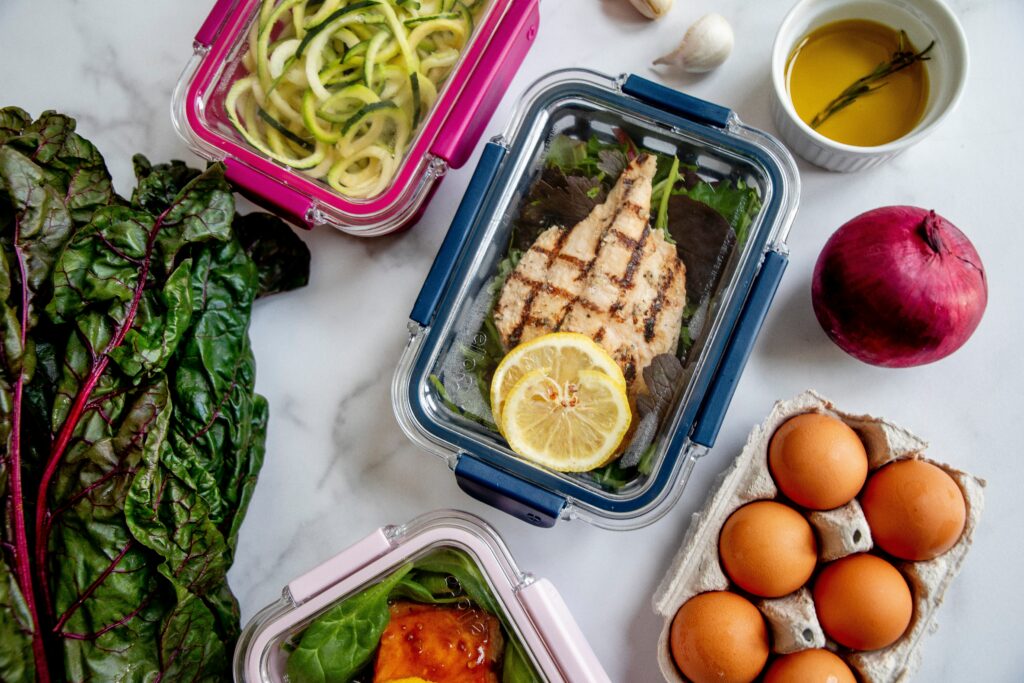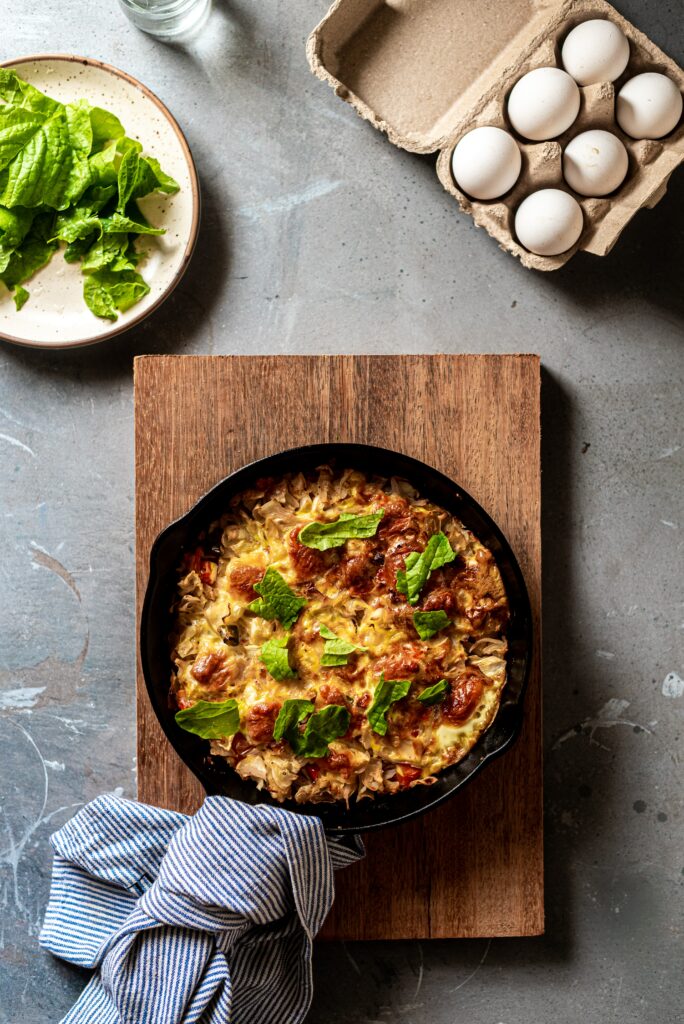Tired of the midday energy slump—those sluggish afternoons where productivity plummets and an iced coffee (or two) feels like a necessity? It’s time to give your lunch routine a protein-powered makeover. Say goodbye to lackluster meals and hello to a lunch that’s satisfying, quick to throw together, and balances blood sugar. With a little bit of effort, high protein lunch prep is the secret weapon to supercharge your day, providing the essential nutrients your body needs for optimal performance and satiation.

why lunch prep is important
Lunch prep is the ultimate ticket to minimizing unnecessary takeout and mindless snacking. When you take time to plan and prep your lunches in advance, you regain control over your dietary choices—no surprise here! Moreover, lunch prep helps you balance your blood sugar levels by ensuring you have a well-rounded meal that includes protein, complex carbohydrates, and healthy fats. Creating a lunch with adequate protein, specifically, helps support muscle repair, satiety, and overall health. This balance keeps your energy levels stable, preventing those dreaded crashes and cravings all afternoon.
The power of protein
When in doubt, prep your protein. Protein is made up of amino acids—the building blocks of many of our hormones. In other words, adequate protein intake is essential for the production of estrogen, progesterone, and testosterone. All of these are critical for reproductive health, mood regulation, and more! Furthermore, protein helps balance blood sugar levels. Unfortunately, when we consume too many starchy foods and sugars, our blood sugar levels spike. Over time, this can lead to hormonal imbalances. High protein lunch prep—that includes protein—is the ticket to happy hormones, stable blood sugar, and overall satiety.

Popular lunch foods that spike blood sugar
As mentioned, an imbalanced lunch (too many starchy carbs and not enough protein, healthy fats, or fiber) will cause a blood sugar spike. In turn, blood sugar crashes and cravings for sugar, caffeine, or a nap arise. Fortunately, there’s a solution! Enter: high protein lunch prep. That said, what are a few popular lunch foods that spike blood sugar?
Refined bread
Packaged white bread is notorious for its high glycemic index. Meaning, it can cause a rapid increase in blood sugar levels. Opt for whole grain (with minimal added sugar), sprouted whole wheat bread, or freshly baked sourdough with simple ingredients.
White Rice
Similar to highly processed white bread, white rice is quickly digested and can cause a spike in blood sugar levels. Choose brown rice, wild rice, or cauliflower rice for a more blood sugar-friendly option.
French Fries
Grabbing takeout with a side of fries? Deep-fried and starchy, French fries can lead to a sharp rise in blood sugar levels due to their high carbohydrate content. Consider swapping them for baked sweet potato fries or roasted vegetables.
Sweetened Beverages
This goes without saying, but sugary drinks—like soda, sweetened iced tea, and energy drinks—are packed with added sugars. These rapidly increase blood sugar levels. Choose sparkling water, unsweetened tea, or water with lemon for a healthier hydration option.
Processed Snack Foods
Many processed snack foods, such as potato chips, pretzels, and crackers, are high in refined carbohydrates that can cause blood sugar spikes. Opt for healthier snack alternatives like nuts, beef jerky, hard-boiled eggs, veggies and hummus, or seedy crackers.
Sugary Salad Dressings
Many salad dressings—especially those labeled as “fat-free” or “low-fat”—contain added sugars to compensate for the reduced fat content. Look for dressings with minimal added sugars (like Primal Kitchen) or make your own using extra-virgin olive oil, dijon mustard, sea salt, black pepper, and lemon juice.
Sweetened Yogurts
Flavored yogurts often contain significant amounts of added sugars, which can lead to blood sugar spikes. Choose plain Greek yogurt and add your own berries (or a drizzle of honey and cinnamon for natural sweetness).
If you’re going to reach for these foods, midday, make sure to balance them with 20-30 grams of protein, 1-2 sources of healthy fats, and half a plate of non-starchy vegetables (i.e. leafy greens). Furthermore, keep in mind that the impact of specific foods on blood sugar levels will vary (depending on factors like portion size and individual metabolism). By wearing a CGM, you can track your blood glucose in real time!

8 High protein lunch prep ideas
Without further ado, below are lunch ideas you can throw together ahead of time. Whether you’re batch-cooking protein or grains—or you’re chopping veggies and roasting a tray of sweet potatoes ahead of time— a little bit of meal prep goes a long way. Whether you work from home or elsewhere, these lunches are easy to take on the go. Enjoy!
1. Quinoa and Black Bean Bowls
Cook a batch of quinoa and cauliflower rice ahead of time. Rinse a can of black beans. Divide the quinoa, caulirice, and black beans into individual containers. For added flavor and nutrients, mix in sautéed vegetables with taco seasoning—like bell peppers and spinach. In the morning, top with avocado, cilantro, lime juice, and hemp seeds. For more protein, enjoy a small bowl of cottage cheese with hot sauce on the side.
2. Greek Yogurt Parfaits
Greek yogurt is an excellent source of protein. Layer it in a mason jar with fresh berries, nuts, hemp seeds, and chia seeds for a protein-rich and satisfying midday meal. This option is quick to assemble and can be easily customized with your favorite fruits and toppings! For added protein, mix the Greek yogurt with a scoop of your favorite protein powder. For additional satiation, bring a single-serve pancake to eat alongside.
3. Tuna Salad Wraps
Make a tuna salad with canned tuna, Greek yogurt or mayo, dijon mustard, chopped celery, diced red onion, fresh dill, lemon juice, sea salt, and black pepper. Spread the mixture on a whole-grain tortilla, add some lettuce or spinach, and roll it up in a tortilla for a protein-packed lunch on the go. Serve with carrot sticks and a handful of walnuts. Sub the tuna for canned salmon or cannellini beans (vegetarian option).
4. Chicken and Vegetable Stir-Fry
Cook a batch of chicken breast and a medley of colorful vegetables like bell peppers, broccoli, and snap peas. Season with low-sugar teriyaki sauce and divide into meal-sized portions. Pair with brown rice and avocado for added fiber and nutrients.
5. Mason Jar Salads
Layer your favorite protein-rich ingredients in a mason jar for a portable and customizable lunch option. Start with a base of grains (like brown rice), then add tofu, chickpeas, hard-boiled eggs, or chopped deli turkey. Top it off with cherry tomatoes, cucumber slices, leafy greens, and a light dressing. When ready to eat, simply shake the jar to mix the ingredients. Pack with a handful of fiber-rich crackers.
6. Turkey or Veggie Wraps
Prepare wraps with whole-grain tortillas filled with lean turkey slices, hummus, provolone cheese, pesto, and plenty of crunchy vegetables like cumber and shredded cabbage. For vegetarian options, substitute turkey with grilled tofu or a variety of roasted vegetables with pesto.
7. Egg Muffins
Whip up a batch of egg muffins by beating eggs with your preferred veggies, like spinach, mushrooms, and bell peppers. For added protein, add chopped breakfast sausages and crumbled goat cheese to the mixture. Pour the mixture into a muffin tin and bake until set. These protein-packed muffins can be refrigerated and reheated for a quick and filling lunch. Pack with a side of avocado and a whole-grain English muffin.
8. Fiber-rich pasta salad
Cook a box of healthy pasta. In a large mixing bowl, add in shredded rotisserie chicken, micro greens, jarred artichokes, black olives, sundried tomatoes, feta, and cucumbers. Toss in a tangy vinaigrette. Portion into tupperware and enjoy all week!

This article contains affiliate links. Thank you for supporting Wellness with Edie! This article is for informational purposes only. It is not, nor is it intended to be, a substitute for professional medical advice, diagnosis, or treatment and we recommend that you always consult with your healthcare provider.



Leave a Reply